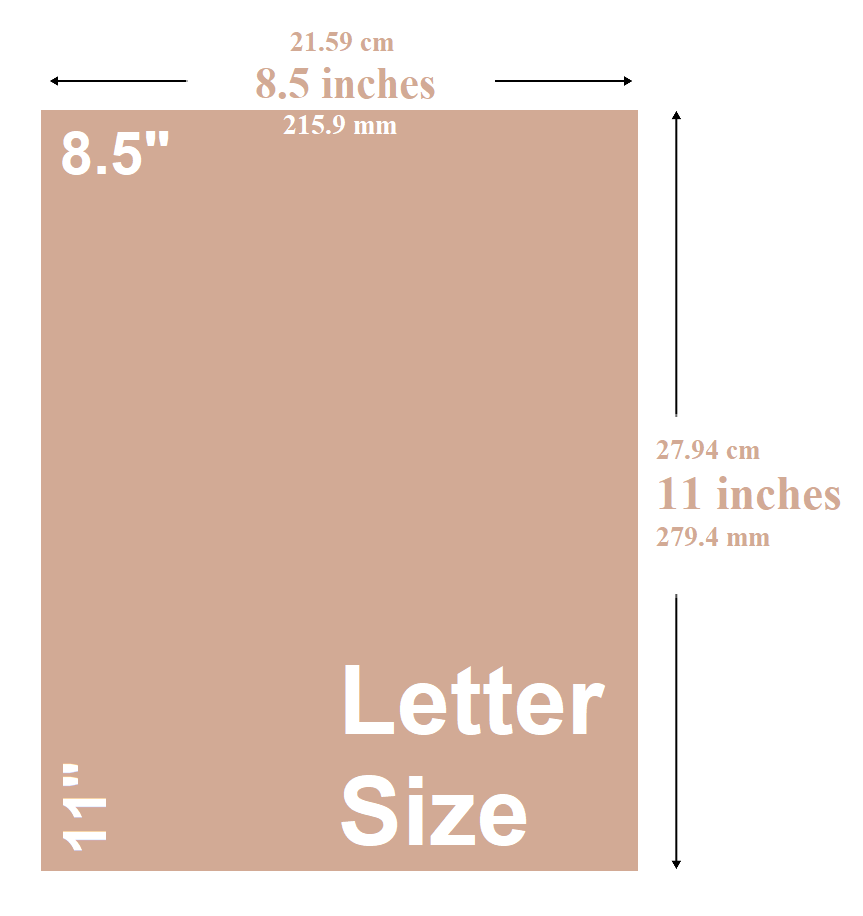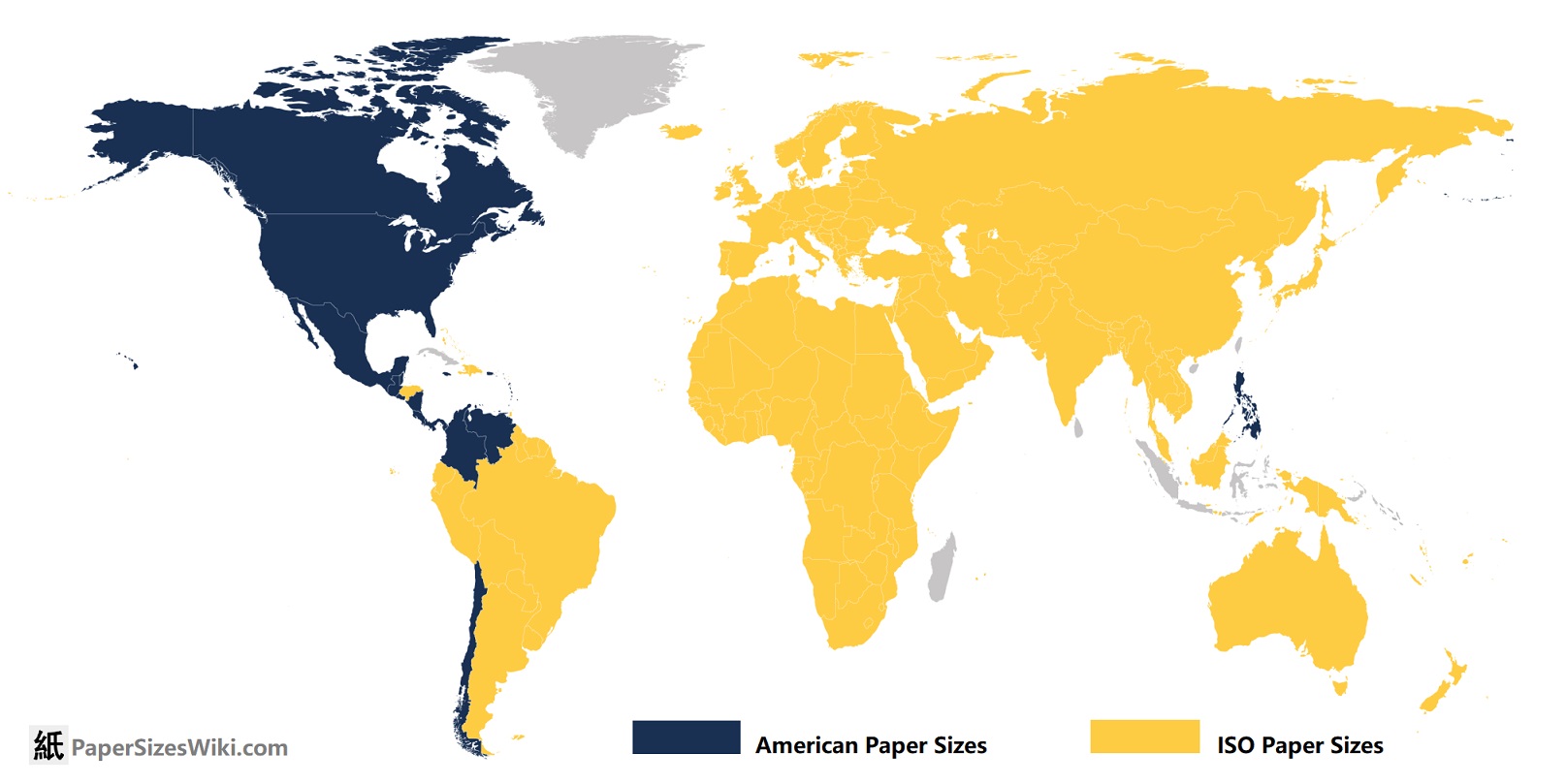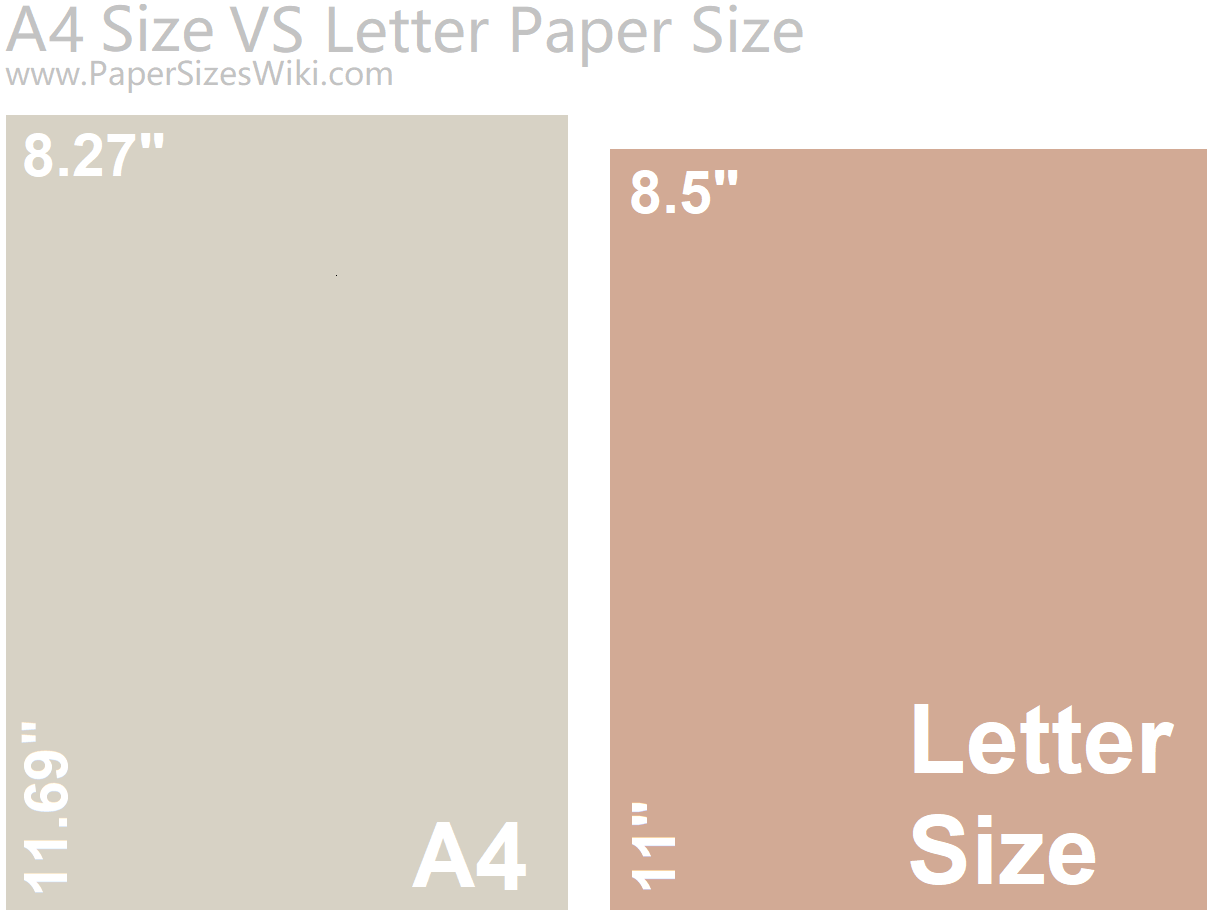If you’ve ever encountered the paper size system in the United States, you may have noticed that it doesn’t quite match what most of the world uses. The Letter paper size, a staple in American offices, schools, and homes, is an intriguing standard that many people outside the US might not be familiar with. In this blog post, we’ll dive into everything you need to know about it, and how it compares to the ISO paper size system used globally.
What is Letter Paper Size
Letter size is a standard dimension for sheets of paper commonly used in the United States, Canada, Mexico, and parts of Central America. It shares the same size dimensions with the ANSI A in the ANSI paper sizes.The term “letter” comes from its historical use for writing letters or correspondence. The 8.5 x 11 paper size was standardized in the U.S. in the 19th century for documents, letters, and other personal and business communications. It has become synonymous with “office paper,” commonly used for everything from printing documents to school assignments.
Dimensions
- In inches: 8.5 inches × 11 inches
- In cm: 21.59 cm × 27.94 cm
- In mm: 215.9 mm x 279.4 mm
- In pixels (at 300 dpi resolution): 2551 px × 3295 px
This is the most commonly used paper size in the US for day-to-day printing and writing. Whether it’s a simple letter, a business document, or a legal agreement, it is right the standard.
Layout

Origin
The history of Letter size is tied to the evolution of paper manufacturing in the 19th century. It is believed that the dimension was derived from the size of early paper sheets used in the United States, which were based on the traditional paper manufacturing sizes in Europe.
The origins of the size are somewhat tied to practical needs of the time. Paper makers in the early United States standardized their paper sizes to match a convenient format for both commercial and domestic use, which happened to be 8.5 x 11 inches. A major turning point occurred in 1921 when the American National Standards Institute (ANSI), under the influence of the National Bureau of Standards, officially adopted 8.5 x 11 inches as the standard size for paper in the U.S. This decision was likely based on the dimensions of early papermaking equipment and their practicality in relation to the folding and binding of documents, particularly letters. The choice also suited the typesetting and printing techniques of the era, allowing businesses and government bodies to print documents on this standardized paper.
While many countries around the world adopted the A-series paper size system from ISO (International Organization for Standardization), the United States stuck with its Letter paper size, which remains prevalent today.
Common Uses
Letter size paper is used for a variety of purposes, both personal and professional. Here are a few common applications:
1. Office Documents
Letter size paper is the go-to choice for most office printing. This includes:
- Business correspondence (letters, memos, and contracts)
- Resumes and cover letters
- Reports and presentations
- Invoices and bills
2. Academic Papers
In the United States and parts of Canada, academic institutions typically require assignments and papers to be printed on Letter size paper. This is the default format for essays, research papers, and thesis submissions.
3. Forms and Stationery
It is also used for personal stationery, including letterheads, forms, and personal letters.
4. Printing and Publishing
Many magazines, newsletters, and booklets printed in the US and Canada are produced on Letter size paper, as this has been the standard for commercial printing.
5. Legal Documents
While there is a separate “Legal” size (8.5 × 14 inches) for more specialized documents, many legal documents are printed on standard Letter paper. Court papers, contracts, and other legal forms often follow this format.
Regions
It is primarily used in North America and a few other regions. Here’s a breakdown:
- United States: The most common paper size, used across all sectors—government, business, education, etc.
- Canada: While the metric system is used in Canada for many things, Letter size paper is still the standard for most office and personal uses.
- Mexico: Similar to the US, Letter paper is widely used in offices and homes.
- Central America: Countries like Guatemala and Honduras also commonly use Letter size paper.
The size is not widely used outside of the Americas. Most other countries follow the ISO A-series paper sizes, especially the A4 size, which is more common in Europe, Asia, and much of the world.

Letter Paper Size in inches
8.5 inches × 11 inches
Letter Paper Size in cm
21.59 cm × 27.94 cm
Letter Paper Size in mm
215.9 mm x 279.4 mm
Letter Size Dimensions Chart
| Size Code | in inches | in mm | in cm |
| Letter | 8.5 x 11 in | 215.9 x 279.4 mm | 21.59 × 27.94 cm |
Letter Paper Size in pixels
Dimensions vary in pixels depending on the PPI/DPI applied.
| Size Code |
72 dpi/ppi (screen resolution) |
96 dpi/ppi (screen resolution) |
300 dpi/ppi (print resolution) |
| Letter | 612 x 791 px | 816 x 1054 px | 2551 x 3295 px |
* PPI (pixels per inch) = DPI (dots per inch) = Resolution
300 PPI is the best printing resolution of digital printer.
Pros and Cons of Letter Paper Size
As with any paper size, there are both advantages and disadvantages to using Letter paper. Below are some of the most common pros and cons associated with Letter size:
Pros
- Familiarity and Tradition: In the U.S. and Canada, Letter size is deeply ingrained in business and personal culture. It’s the default size for most documents, making it familiar and accessible for most people.
- Convenient for Office Equipment: Most office printers, copiers, and scanners in North America are optimized for Letter size paper, ensuring easy compatibility and low-cost printing.
- Standard for Legal Documents: Many legal forms and documents in North America are formatted for Letter size, making it the preferred choice for legal professionals and institutions in the region.
- Widely Available: Letter-sized paper is widely available in a range of qualities and finishes, making it an easy choice for any printing need, from office memos to business reports.
Cons
- Not Internationally Compatible: The biggest downside of Letter paper is that it is not the global standard. If you’re working internationally, documents formatted in Letter size may need adjustments to match A4 or other ISO standards.
- Inefficient for Global Printing: In global businesses, having to convert documents from Letter to A4 can create inefficiencies, especially when printing, scanning, or faxing documents across borders.
- Space Inefficiency: The aspect ratio of Letter paper (width to height) is not as space-efficient as A4 paper, leading to more wasted space on documents printed or scanned at different sizes.
Letter Size vs. A4 Size
If you’re accustomed to using the A4 paper size, which is the most common international standard paper size, you might be wondering how it compares to the US Letter size.
A4 size has the following dimensions:
- In inches: 8.27 inches × 11.69 inches
- In cm: 21 cm × 29.7 cm
- In mm: 210 mm x 297 mm
- In pixels (at 300 dpi): 2480 px × 3508 px

Key Differences:
- Height: Letter paper is slightly shorter (11 inches vs. 11.69 inches).
- Width: Letter paper is slightly wider (8.5 inches vs. 8.27 inches).
- Aspect Ratio: A4 paper has a more balanced aspect ratio (1:1.414), while Letter paper has an aspect ratio closer to 1:1.3. This subtle difference can make a significant impact on document layout and printing.
Despite the differences in size, both Letter and A4 are widely supported by modern printers, so if you’re printing in the US or internationally, most printers can handle both without issues.
Converting Letter to A4 (and Vice Versa)
If you’re working internationally and need to convert between Letter and A4 paper sizes, here are some things to keep in mind:
- Printing: When printing documents, ensure your printer settings are set to the correct paper size. Most modern printers allow you to select either Letter or A4, but make sure to adjust the settings before printing.
- Document Formatting: When converting a document between Letter and A4, you may need to adjust the margins or scale the document slightly to ensure it fits the page size. This can be done easily with most word processors like Microsoft Word, Google Docs, or Adobe Acrobat.
Main Facts
The Letter paper size is a significant standard in North America, and while it’s often seen as peculiar to those outside the US, it plays an essential role in business, education, and daily life across many regions. Understanding the dimensions, origin, uses, and the comparison to international paper sizes like A4 helps bridge the gap between different systems of measurement and makes it easier to work across borders.
Whether you’re using Letter paper for printing a report, signing a contract, or simply writing a letter, this size remains integral to how the world communicates and works—especially in countries like the US, Canada, and Mexico.
For people outside the US, getting familiar with it will help you navigate international printing standards, and you’ll know exactly how it compares to the more widely used A4 format. It’s all about understanding the systems in place and making sure your documents are well-prepared, no matter where you’re located. Let us know for more questions about it.